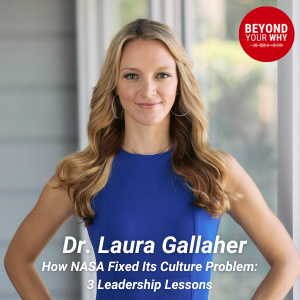Guest: Dr. Laura Gallaher
WHY.os: Contribute – Challenge – Simplify
Dr. Laura Gallaher is an organizational psychologist, speaker, and business consultant who helps companies build better cultures. She was part of NASA’s culture change initiative after the Columbia disaster, working to fix deep issues in leadership, communication, and decision-making. Now, as the founder of Gallaher Edge, she teaches executives how to improve their teams by focusing on self-awareness, emotional intelligence, and psychological safety.
In this episode, you’ll learn:
- Why smart people still make bad decisions – and how self-deception holds businesses back.
- The key to high-performing teams – and why psychological safety matters more than talent.
- How to create a company culture that works – instead of one that forms by accident.
Listen now to get insights that will help you lead better, communicate more effectively, and build a stronger organization.
Connect with Dr. Gallaher!
Watch the episode here
00:07 – The WHY of Contribute: Adding Value to Others
01:59 – Leadership and Perfectionism in High School
04:17 – Discovering a Passion for Psychology
07:55 – Emotional Regulation: A Key to Leadership Success
09:19 – Psychological Safety and High-Performing Teams
12:57 – NASA’s Culture Problem and the Columbia Disaster
20:50 – The Unexpected Start of Gala Her Edge
23:14 – What Is Company Culture, Really?
27:25 – Can You Design a Culture? Absolutely.
33:56 – The Best Advice: “All We Have is Now”
Listen to the podcast here
How NASA Fixed Its Culture Problem – And What Your Business Can Learn from It
Most businesses don’t think about culture until something goes wrong. A project fails. A team falls apart. An employee quits without warning. But what if I told you that NASA—yes, rocket scientists—had a culture problem so bad it led to the Columbia disaster? And what if I told you that fixing it came down to something every company struggles with—communication, leadership, and trust?
Dr. Laura Gallaher knows exactly what went wrong and, more importantly, how to fix it. As an organizational psychologist, she was hired by NASA after the Columbia accident to help change the way people worked together—because, as it turned out, the biggest risk to space travel wasn’t technology. It was silence. Today, she helps business leaders stop the toxic patterns that keep teams from reaching their full potential. If you’ve ever wondered why smart people make bad decisions or why your team struggles to speak up, this episode of Beyond Your WHY has the answers.
The Cost of Staying Silent: What NASA’s Culture Problem Revealed
After the Columbia accident, the investigation found something shocking: NASA’s culture—not faulty engineering—was to blame. There were engineers who saw the problem before the disaster, but they didn’t push hard enough to be heard. Why? Because the culture told them not to.
“There was a belief that if you didn’t have data, you didn’t have a voice,” Dr. Gallaher explains. “People were afraid to speak up because they thought they’d be dismissed. And when no one speaks up, bad decisions happen.”
Most businesses don’t send rockets into space, but the same problem exists everywhere. Employees don’t bring up concerns. Leaders don’t ask enough questions. People assume everything is fine—until it isn’t. Psychological safety—the ability to speak openly without fear—is the secret weapon of high-performing teams. Without it, businesses make costly mistakes, and employees disengage.
Emotional Regulation: The Leadership Skill No One Talks About
Ask someone what makes a great leader, and you’ll hear things like “vision,” “strategy,” or “decision-making.” But one of the strongest predictors of leadership success is emotional regulation—a leader’s ability to manage emotions instead of being controlled by them.
Dr. Gallaher saw this firsthand at NASA and in the companies she consults for today. “If leaders can’t regulate their emotions, they create a culture of fear,” she says. “Employees start avoiding difficult conversations, and before you know it, you have major blind spots in your business.”
The best leaders don’t suppress emotions—they learn to manage them. That means recognizing when frustration, stress, or fear is driving a decision and choosing to respond instead of react. It’s a skill that doesn’t just make leadership easier—it creates an environment where people feel safe to contribute. And when people feel safe, they perform better.
Culture Isn’t an Accident—It’s a Choice
Most companies have a culture by default, not by design. The problem? If you’re not shaping it, it’s shaping you—and not always in a good way. Dr. Gallaher emphasizes that culture isn’t just about perks or mission statements. It’s about what people actually believe and do every day.
“Culture is an emergent property,” she says. “It’s not something you can fix with a one-time initiative. It’s the result of how leaders behave, how decisions are made, and what behaviors are rewarded.”
That means if you want a culture where people speak up, leaders have to model it first. If you want teams to be honest about problems, they need to see that honesty is valued—not punished. And if you want people to take ownership, they need to believe their voice matters.
The Takeaway
Fixing NASA’s culture wasn’t about slogans or training sessions. It was about changing the way people interacted—at every level. The same is true for your business. If your team struggles with trust, communication, or decision-making, the solution isn’t a new strategy. It’s changing the way people work together.
Want to learn more about building a culture that actually works? Listen to the full episode with Dr. Laura Gallaher and start making small, powerful shifts today.

